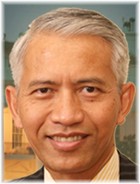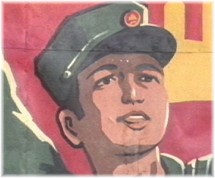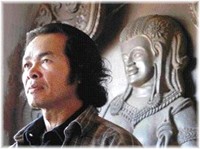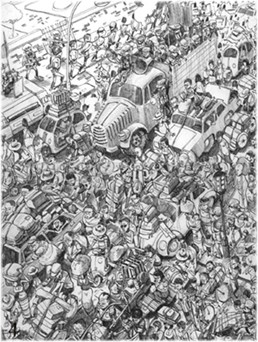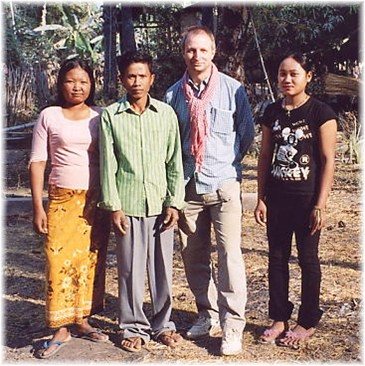Following on from the Tribune interview with Rithy Panh, I came across this review by the investigative journalist and author
John Pilger on Rithy Panh's stunning film,
S-21: The Khmer Rouge Killing Machine. Any article by John Pilger is worth a second look. As is any film by Rithy Panh.
A journey through genocide. S21: The Khmer Rouge Killing Machine forces Pol Pot's former torturers to confront their victims. The result is remarkable,
writes John Pilger January 29, 2004, in The Guardian newspaper.
"It is my duty," wrote the correspondent of the Times at the liberation of Belsen, "to describe something beyond the imagination of mankind." That was how I felt in the summer of 1979, arriving in Cambodia in the wake of Pol Pot's genocidal regime.
In the silent, grey humidity, Phnom Penh, the size of Manchester, was like a city that had sustained a nuclear cataclysm which had spared only the buildings. Houses, flats, offices, schools, hotels stood empty and open, as if vacated that day. Personal possessions lay trampled on a path; traffic lights were jammed on red. There was almost no power, and no water to drink. At the railway station, trains stood empty at various stages of interrupted departure. Several carriages had been set on fire and contained bodies on top of each other.
When the afternoon monsoon broke, the gutters were suddenly awash with paper; but this was money. The streets ran with money, much of it new and unused banknotes whose source, the National Bank of Cambodia, had been blown up by the Khmer Rouge as they retreated before the Vietnamese army. Inside, a pair of broken spectacles rested on an open ledger; I slipped and fell hard on a floor brittle with coins. Money was everywhere. In an abandoned Esso station, an old woman and three emaciated children squatted around a pot containing a mixture of roots and leaves, which bubbled over a fire fuelled with paper money: thousands of snapping, crackling riel, brand-new from the De La Rue company in London.
With tiny swifts rising and falling almost to the ground the only movement, I walked along a narrow dirt road at the end of which was a former primary school called Tuol Sleng. During the Pol Pot years it was run by a kind of gestapo, "S21", which divided the classrooms into a "torture unit" and an "interrogation unit". I found blood and tufts of hair still on the floor, where people had been mutilated on iron beds. Some 17,000 inmates had died a kind of slow death here: a fact not difficult to confirm because the killers photographed their victims before and after they tortured and killed them at mass graves on the edge of the city. Names and ages, height and weight were recorded. One room was filled to the ceiling with victims' clothes and shoes, including those of many children.
Unlike Belsen or Auschwitz, Tuol Sleng was primarily a political death centre. Leading members of the Khmer Rouge movement, including those who formed an early resistance to Pol Pot, were murdered here, usually after "confessing" that they had worked for the CIA, the KGB, Hanoi: anything that would satisfy the residing paranoia. Whole families were confined in small cells, fettered to a single iron bar. Some slept naked on the stone floor. On a school blackboard was written:
1. Speaking is absolutely forbidden.
2. Before doing something, the authorisation of the warden must be obtained.
"Doing something" might mean only changing position in the cell, and the transgressor would receive 20 to 30 strokes with a whip. Latrines were small ammunition boxes labelled "Made in USA". For upsetting a box of excrement the punishment waslicking the floor with your tongue, torture or death, or all three.
This is described, perhaps as never before, in a remarkable documentary, S21: The Khmer Rouge Killing Machine, by Tuol Sleng's few survivors. The work of the Paris-based Khmer director Rithy Panh, the film has such power that, more than anything I have seen on Cambodia since I was there almost 25 years ago, it moved me deeply, evoking the dread and incredulity that was a presence then. Panh, whose parents died in Pol Pot's terror, succeeded in bringing together victims and torturers and murderers at Tuol Sleng, now a genocide museum.
Van Nath, a painter, is the principal survivor. He is grey-haired now; I cannot be sure, but I may have met him at the camp in 1979; certainly, a survivor told me his life had been saved when it was found he was a sculptor and he was put to work making busts of Pol Pot. The courage, dignity and patience of this man when, in the film, he confronts former torturers, "the ordinary and obscure journeymen of the genocide", as Panh calls them, is unforgettable.
The film has a singular aim: a confrontation, in the best sense, between the courage and determination of those like Nath, who want to understand, and the jailers, whose catharsis is barely beginning. There is Houy the deputy head of security, Khan the torturer, Thi who kept the registers, who all seem detached as they recall, almost wistfully, Khmer Rouge ideology; and there is Poeuv, indoctrinated as a guard at the age of 12 or 13. In one spellbinding sequence, he becomes robotic, as if seized by his memory and transported back. He shows us, with moronic precision, how he intimidated prisoners, fastened their handcuffs and shackles, gave or denied them food, ordered them to piss, threatening to beat them with "the club" if a drop fell on the floor. His actions confront all of us with the truth about human "cogs" in machines whose inventors and senior managers politely disclaim responsibility, like the still untried Khmer Rouge leaders and their foreign sponsors.
Panh, whose film-making is itself an act of courage, sees something positive in the mere act of bearing witness and, speaking of the prisoners, in "the resistance [that is] a form of dignity that is profoundly human". He refers to the "little things, these unsubstantial details, so slight and fragile, which make us what we are. You can never entirely 'destroy' a human being. A trace always remains, even years later ... a refusal to accept humiliation can sometimes be conveyed by a look of defiance, a chin slightly raised, a refusal to capitulate under blows ... The photographs of certain prisoners and the confessions conserved at Tuol Sleng are there to remind us of it."
It seems almost disrespectful to take issue at this point; but one must. For too long Pol Pot and his gang have been an iconic horror show in the west, stripped of the reasons why. And this extraordinary film, it has to be said, adds little to the why. When Pol Pot died in his bed a few years ago, I was asked by a features editor to write about him. I said I would, but that the role of "civilised" governments in bringing him to power, sustaining his movement and rejuvenating it was a critical component. He wasn't interested.
The genocide in Cambodia did not begin on April 17 1975, "Year Zero". It began more than five years earlier when American bombers killed an estimated 600,000 Cambodians. Phosphorous and cluster bombs, napalm and dump bombs that left vast craters were dropped on a neutral country of peasant people and straw huts. In one six-month period in 1973, more tons of American bombs were dropped on Cambodia than were dropped on Japan during the second world war: the equivalent of five Hiroshimas. The regime of Richard Nixon and Henry Kissinger did this, secretly and illegally.
Unclassified CIA files leave little doubt that the bombing was the catalyst for Pol Pot's fanatics, who, before the inferno, had only minority support. Now, a stricken people rallied to them. In Panh's film, a torturer refers to the bombing as his reason for joining "the maquis": the Khmer Rouge. What Nixon and Kissinger began, Pol Pot completed. And having been driven out by the Vietnamese, who came from the wrong side of the cold war, the Khmer Rouge were restored in Thailand by the Reagan administration, assisted by the Thatcher government, who invented a "coalition" to provide the cover for America's continuing war against Vietnam.
Thank you, Rithy Panh, for your brave film; what is needed now is a work as honest, which confronts "us" and relieves our amnesia about the part played by our respectable leaders in Cambodia's epic tragedy.
© John Pilger 2004.
You can read more about the film S-21 at my own
website. For my own visit to S-21 in March 1998, click
here.
 CamKids is a newly-launched charity, based in the UK. Mark Purser is the Chairman of CamKids, or its full title, The Cambodian Children’s Charity. Mark and his wife are parents of a 5 year old girl, who they adopted from Cambodia two years ago and, together with a couple of other Cambodian adoptive families and a number of supporters, they decided to form the charity last year. Its official launch took place in London last month. They have been supporting children’s projects in Cambodia for a number of years and decided to formalise their work and to increase their activities. CamKids mainly support educational and medical projects, as well as relief work, in rural areas in Cambodia. Last year, they built a small medical centre at a rural orphanage in the village of Kais, in Kompong Speu province, for use by the children and the local community. They also pay for a doctor to attend regularly, as well as the medicines, vaccines and other supplies. At the moment, they're building a kitchen and canteen at the same orphanage and are working on plans for the construction and support of two rural schools, including teacher training, as well as increasing their dental and medical programs. They are non-political and non-religious and they also try to support local businesses and suppliers when carrying out their projects. You can find out more about this fledgling charity at their website and on their blog.
CamKids is a newly-launched charity, based in the UK. Mark Purser is the Chairman of CamKids, or its full title, The Cambodian Children’s Charity. Mark and his wife are parents of a 5 year old girl, who they adopted from Cambodia two years ago and, together with a couple of other Cambodian adoptive families and a number of supporters, they decided to form the charity last year. Its official launch took place in London last month. They have been supporting children’s projects in Cambodia for a number of years and decided to formalise their work and to increase their activities. CamKids mainly support educational and medical projects, as well as relief work, in rural areas in Cambodia. Last year, they built a small medical centre at a rural orphanage in the village of Kais, in Kompong Speu province, for use by the children and the local community. They also pay for a doctor to attend regularly, as well as the medicines, vaccines and other supplies. At the moment, they're building a kitchen and canteen at the same orphanage and are working on plans for the construction and support of two rural schools, including teacher training, as well as increasing their dental and medical programs. They are non-political and non-religious and they also try to support local businesses and suppliers when carrying out their projects. You can find out more about this fledgling charity at their website and on their blog.